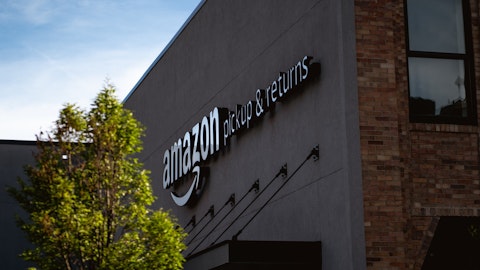The Goldman Sachs Group, Inc. (NYSE:GS) Q3 2023 Earnings Call Transcript October 17, 2023
Operator: Good morning. My name is Taryn and I will be your conference facilitator today. I would like to welcome everyone to the Goldman Sachs Third Quarter 2023 Earnings Conference Call. On behalf of Goldman Sachs, I will begin the call with the following disclaimer. The earnings presentation can be found on the Investor Relations page of our website and contains information on forward-looking statements and non-GAAP measures. This audio cast is copyrighted material of the Goldman Sachs Group, Inc. and may not be duplicated, reproduced or rebroadcast without our consent. This call is being recorded today, October 17th, 2023. I will now turn the call over to Chairman and Chief Executive Officer, David Solomon; and Chief Financial Officer, Denis Coleman. Thank you. Mr. Solomon, you may begin your conference.
David Solomon: Thank you very much, and good morning, everybody. Thank you all for joining us. Before I start my prepared remarks, I’d just like to take a moment to address the horrific events in the Middle East. We condemn the terrorist attacks against Israel on the strongest possible terms and are heartbroken by the loss of so many innocent lives. This is clearly an extremely difficult and uncertain time for the region, and it’s very concerning for many of us around the world. We obviously will continue to watch closely as this crisis unfolds. Earlier this month, I marked the end of my fifth year as the CEO of Goldman Sachs. I’ve never felt more optimistic about the firm, and our strategy has never been more clear. We operate two core businesses, our market-leading Global Banking & Markets franchise, and our growing Asset & Wealth Management platform, both of which are being positioned to deliver mid-teen returns through the cycle.

nick-pampoukidis-t-UV1rZqPuY-unsplash
As I reflect on the past five years, much of what has always made Goldman Sachs extraordinary remains the same, long track record of being a trusted adviser to the world’s leading businesses, institutions and individuals. A global broad and deep platform with capabilities that span across products, geographies and solutions, an aspirational brand, exceptional people and a culture of collaboration and excellence. Additionally, over this time, we have evolved the organization by institutionalizing a One Goldman Sachs operating ethos. This approach, coupled with our best-in-class talent, advice and execution capabilities has strengthened and solidified our leadership position across our businesses. As we sit here today, our client franchise is as strong as ever, enabling us to remain at the center of the most complex and important transactions for our clients.
For example, the IPO market has started to reopen. Since Labor Day, there have been four marquee IPOs priced in the United States, Arm Holdings, Instacart, Klaviyo and Birkenstock. Goldman Sachs was lead left on three of those four and the joint lead book runner on the fourth. No other bank can make that claim. Being entrusted to help companies navigate the critical transition of coming to market requires long-standing client relationships, deep market expertise and experience. Given the execution of these transactions, I’m encouraged by the prospects of a wider reopening of capital markets. If conditions remain conducive, I expect the continued recovery for both capital markets and strategic activity. As a leader in M&A advisory and equity underwriting, a resurgence in activity would be a tail [indiscernible] of Goldman Sachs.
In Asset & Wealth Management, our strategy is working as evidenced by the successes we’ve seen across our franchise. While some active asset managers have faced quarterly outflows over the last few years, we posted our 23rd consecutive quarter of long-term fee-based inflows. We generated record management and other fees of $2.4 billion and are well on our way of achieving our $10 billion annual target to 2024. We are also ahead of pace on our $2 billion target for alternative management fees. While market-leading client franchise allows us to execute from a position of strength, we know we still have work ahead of us. Earlier this year at Investor Day, we laid out a clear set of goals to narrow our strategic focus, and we have made significant progress on these priorities.
Most recently, we announced the sale of GreenSky. We also announced the sale of Personal Financial Management this summer. We sold substantially all of our markets loan portfolio. We have reduced our historical principal investments by $9 billion this year. We are confident that the work we’re doing now provides us a stronger platform for 2024 and beyond. As we assess the operating backdrop, the US economy has proven to be more resilient than expected, though there are reasons to remain vigilant. Treasury rates have risen sharply over the past few months with 10-year yields up 75 basis points in the third quarter. On top of that, recent inflation and employment data has come in above estimates, driving market expectations of higher for longer interest rates.
And there still are a number of sectors in the economy that have yet to absorb the impact of higher rates, especially in light of the further tightening in financial conditions we’ve seen over the last quarter. At the same time, there has been an escalation of geopolitical stresses around the globe, the [indiscernible] war in Ukraine, tensions with China and now the conflict in the Middle East. Overall levels of risk are more elevated than we’ve seen in quite some time. While we don’t know where this will all lead, it could impact economic growth and stability in the U.S. and around the world, and we remain cautiously positioned. Before I turn it over to Denis, I’d like to spend a moment on Basel III Endgame proposal and reiterate my views on it.
We, of course, support sensible regulation and the desire to ensure we have a safe and sound financial system. There are some who have recently said we need to address the lessons from the 2008 financial crisis, which is driving the needs of much higher regulations. But frankly speaking, the rules, as proposed, go way too far and do not account for the vast array of improvements made by the largest banks as a result of Dodd-Frank and other reforms. Not only have banks doubled capital over the last 15 years, have improved the quality of capital, increased liquidity, simplified businesses that have been subjected to ongoing annual stress tests. Requiring too much capital will have negative consequences. I believe if these rules are implemented, three things will happen.
First, the cost of credit will go up for businesses of all sizes from large corporations to small businesses. Second, more activity will move to the unregulated shadow banking sector. Policies that incentivize a transfer of risk outside the regulated banking system could, in fact, increase systemic risk. And third, US competitiveness will go down. Our capital markets are the deepest and the most liquid in the world. They’re the engine of our economy as access to capital allows for innovation and growth across the country. Our competitive standing as the leading global economy would be negatively impacted by this proposal. The net result of these proposed rules would be slower economic growth in the US, material improvement in the — soundness of the banking system.
We, alongside clients and others in the industry, have been engaging heavily with our regulators and government stakeholders, and given this engagement, we expect that there will be ongoing debate and ultimately, changes to the proposed rules. Though regulatory uncertainty and geopolitical risks remain top of mind, I feel very confident about the state of our client franchise and the long-term opportunities for Goldman Sachs. We are focused on the execution of our strategy to further strengthen our leading Global Banking & Markets franchise and grow our Asset & Wealth Management business. I feel good about the relative performance in our core business, and we remain firmly committed to delivering for clients and shareholders. I will now turn it over to Denis to cover financial results for the quarter.
Denis Coleman: Thank you, David. Good morning. Let’s start with our results on page one of the presentation. In the third quarter, we generated net revenues of $11.8 billion and net earnings of $2.1 billion, resulting in a [indiscernible] and a return on equity of 7.1%. As David highlighted, earlier this year, we made the strategic decision to narrow our focus, and we made strong progress across a number of activities. We provide details on the financial impact related to these decisions in the selected items table. In aggregate, these items reduced net earnings by $828 million, EPS by $2.41 and our ROE by 3.1 percentage points. These items include results related to our historical principal investments within Asset & Wealth Management, including the net impact of marks, sell-downs and CIE impairments as well as results relating to GreenSky, which includes the impact of our announced sale and ongoing operating results.
Additionally, we highlight modest ongoing losses in connection with our residual markets portfolio and operating the PFM business. Turning to performance by segment, starting on page four. Global Banking & Markets produced revenues of $8 billion in the third quarter. Advisory revenues of $831 million were down versus a strong prior year period amid lower completions. Equity underwriting revenues rose year-over-year to $308 million, though industry volumes remained well below medium and longer-term averages. Debt underwriting revenues of $415 million also rose versus the third quarter of 2022. For the year-to-date, we ranked Number One in the league tables across announced and completed M&A as well as equity underwriting and ranked number two in high-yield debt.
Our backlog fell quarter-on-quarter as we successfully brought transactions to market. Though market conditions are dynamic, client engagement continues to be elevated, and our best-in-class franchise remains well positioned to support the needs of our clients as they access the capital markets. FICC net revenues were $3.4 billion in the quarter, down from a strong performance last year, particularly in currency and commodities and up relative to the second quarter. We produced record FICC financing revenues of $730 million grow sequentially on better results within mortgages and structured products. Additionally, we were pleased to win the bids for two pools of Signature Bank’s capital call facilities, totaling just over $15 billion in commitments that were held for auction by the FDIC in September.
As we spoke about at our Investor Day, alternative asset managers are an attractive client set for us, and the purchase of this portfolio allows us to increase our connectivity with this client base, who we can serve even more holistically with our One Goldman Sachs approach. These activities also enable us to grow durable revenues at attractive risk-adjusted returns. Equities net revenues were $3 billion in the quarter. Equities intermediation revenues of $1.7 billion rose 7% year-over-year on better performance in derivatives, while equities financing revenues of $1.2 billion were lower versus a record in quarter. Total financing revenues across FICC and Equities were nearly $6 billion for the year-to-date, representing a record performance for these more durable activities.
Our financing results, combined with the substantial share gains we’ve made since our first Investor Day are the direct result of the successful execution of our stated strategic priorities for this business. We are raising the floor in Global Banking & Markets as reflected by our year-to-date ROE of 13.4% despite muted activity levels across Investment Banking. Now moving to Asset & Wealth Management on page five. Revenues of $3.2 billion were lower year-over-year, primarily driven by weaker results in equity investments. Management and other fees increased 7% year-over-year to a record $2.4 billion, largely driven by higher average assets under supervision. Private banking and lending revenues were $687 million, up slightly year-on-year, as higher deposit balances and spreads were offset by our sale of substantially all of the market loan portfolio.
We remain very focused on driving growth in the more durable revenue streams of management and other fees as well as private banking and lending, both of which generated record revenues for the year-to-date period. Equity investments generated net losses of $212 million, driven by markdowns on investments in commercial real estate. In aggregate, the losses from our historical principal investments as well as the results for Marcus loans negatively impacted our 6% pre-tax margin for the segment by 18 percentage points for the year-to-date. Now moving to page six. Total assets under supervision ended the quarter at $2.7 trillion. We saw $11 billion of liquidity inflows and $7 billion of long-term net inflows, representing our 23rd consecutive quarter of long-term fee-based inflows.
Turning to page seven on alternatives. Alternative AUS totaled $267 billion at the end of the third quarter, driving $542 million of management and other fees for the quarter. Gross third-party fundraising was $15 billion for the quarter and $40 billion for the year-to-date. We were pleased to announce the close of Goldman Sachs Vintage Fund IX in the third quarter, our largest private equity secondaries fund and one of the largest in history at approximately $14 billion. Total third-party fundraising since our 2020 Investor Day is now $219 billion, putting us well on pace to hit our $225 billion target ahead of schedule. On-balance sheet alternative investments totaled approximately $49 billion, of which roughly $21 billion is related to our historical principal investment portfolio.
In the third quarter, we reduced this portfolio by over $3 billion, bringing year-to-date reductions to $9 billion. We are on track to achieve our 2024 year-end target of a historical principal investment portfolio below $15 billion. Next, Platform Solutions, page eight. Revenues were $578 million, including a $123 million revenue reduction related to the GreenSky loan book, which was more than offset by a $637 million associated reserve release as we moved the portfolio to held for sale. On page nine firm-wide net interest income was $1.5 billion in the third quarter, down sequentially as increased funding cost supported trading activities. Our total loan portfolio at quarter end was $178 billion, flat with the prior quarter. Our provision for credit losses was $7 million, which reflected net charge-offs in our credit card lending portfolio, offset by the reserve release I mentioned related to GreenSky.
Additionally, within our wholesale portfolio, impairments were partially offset by a reserve reduction that was driven by increased stability in the macroeconomic environment versus the prior quarter. On page 10, we provide additional detail on our CRE exposure similar to last quarter. CRE loans continue to represent a relatively small percentage of our overall lending book at 14%. CRE investments are diversified across geographies and positions, with no single position representing more than 1% of the total on-balance sheet alternative investments. Across both equity investments and CIEs, we have marked or impaired office-related exposures by approximately 50% this year. Now turning to expenses on page 11. Total quarterly operating expenses were $9.1 billion.
Our year-to-date compensation ratio, net of provisions, is 34.5%, inclusive of approximately $275 million of year-to-date severance costs. At Investor Day in February, we articulated a goal of $600 million in run rate payroll efficiencies to be achieved in 2023 and 2024 and we are currently tracking to surpass that goal. These efficiencies allow us to reinvest in our highest performing people, particularly as the market for top talent remains fiercely competitive. Quarterly non-compensation expense were $0.9 billion. The year-over-year increase in noncomp expenses was driven by the write-down of $506 million in the intangibles related to GreenSky as well as CIE impairments of $358 million. While onetime expenses have been elevated for the year-to-date, we continue to focus on bringing down noncomp expenses and are making progress on our $400 million run rate efficiency goal.
Our effective tax rate for the first nine months of 2023 was 23.3%, high versus the first half due to the write-off of deferred tax assets related to GreenSky and the geographic mix of our earnings. For the full year, we expect a tax rate of under 23%. Now onto slide 12. Our common equity Tier 1 ratio was 14.8% at the end of the third quarter under the standardized approach, 180 basis points above our current capital requirement of 13%. In the quarter, we returned $2.4 billion to shareholders, including common stock repurchase of $1.5 billion and common stock dividends of $937 million. Given the uncertainty around the capital rules at this time, we expect to moderate fourth quarter share repurchases versus the third quarter. We remain committed to paying our shareholders a sustainable growing dividend and maintaining a competitive yield.
In conclusion, our third quarter results reflect the ongoing narrowing of our strategic focus and the execution of our priorities, which will help drive our businesses to produce mid-teens returns through the cycle. We are confident in our ability to deliver for shareholders while continuing to support our clients and remain optimistic about the future opportunity set for Goldman Sachs. With that, we’ll now open up the line for questions.
Operator: Ladies and gentlemen, we will now take a moment to compile the Q&A roster. [Operator Instructions] We’ll take our first question from Glenn Schorr with Evercore ISI. Please go ahead.
See also The 30 Most Underpaid Jobs in America and 15 Skills Employers Look for in Candidates.
Q&A Session
Follow Goldman Sachs Group Inc (NYSE:GS)
Follow Goldman Sachs Group Inc (NYSE:GS)
Glenn Schorr: Hi. Thanks so much. I guess just big picture, if we add back all the significant items in the quarter, we’re obviously still well short of the mid-teens targets. I know this is super slow times, like decade lows in investment banking, and you’re in the process of hopefully reducing a lot of on-balance sheet stuff. So I wonder if you could help us bridge the gap from here to there because in the back of our mind, we also have the potentially up to 25% increase in the denominator. So I wonder if you could bridge the gap of like how much is — comes, do you think, from improvement in capital markets activity? How much is yet to be freed up capital from the denominator? I know it’s tough but I want to say high level [indiscernible] pieces and thanks.
David Solomon: Sure, Glenn, and appreciate the question. And so we’ll keep it high level and let’s separate into what we’ve got and then we can have a separate discussion about Basel III. But first, we are simplifying the firm and kind of managing the firm to drive us toward the overwhelming majority of the firm to be in two core businesses, our Global Banking & Markets franchise, which is performing very well in an environment that’s not a great environment for that business. Investment Banking activities are well below 10-year norms. I don’t think that will stay that way. But if you look at the performance of the business through nine months, that business, which is kind of 7% of the firm, that is two-thirds to 70% of the firm, that business is operating with a 13.4% ROE and an environment that’s not the best environment for that overall business.
I can’t tell you when the environment will get better, but I do believe that the capital markets and banking environment will improve in the coming years. History tells us that it doesn’t stay short — it doesn’t stay closed for multiple years at a time. There is an adjustment. We’re making the adjustment. Yes, the world’s uncertain. As we mentioned, that could be a headwind. But I do think it will improve. And that business performs well. And we firmly believe that, that business is a mid-teens through the cycle business, the way we’ve materially grown our wallet shares, the way we’ve grown our financing footprint, which adds more balance to the business and with our market-leading franchises across that business. Second, we have the Asset & Wealth Management business, which we believe is mid-teens or higher returns as we reduce the historical principal and make it a lower capital business.
We’re on that journey. I think you see us making progress. We’ve talked about how we’ve reduced the historical principal businesses — the historical principal investments by $9 billion this year. We set a target for $15 billion by next year, which we’ll meet and then close to zero two years later. And so that business, we have a high degree of confidence we’ll operate at mid-teens or higher as we reposition it. As we’ve also stated, we’re reducing the drag in our platforms. We’re narrowing the platforms and reducing the drag. And we’re relatively confident that over the next 12 to 24 months, we’ll make materially more progress in that. So you add that up with what we have and I think you can get very comfortable with the mid-teens target. Now, the Basel rules.
The Basel rules, if they were implemented as they’re position now would be a headwind to that but also that doesn’t account for how we optimize and how we pass through pricing. We’ve seen things before. I’m not to saying it won’t be a headwind, but I don’t want to speculate on what it would do to our targets until we actually understand how it’s coming through and what we can do across our businesses to appropriately manage it. So we continue to be very optimistic about our view to deliver meaningfully higher returns to our shareholders. And when there’s more clarity on Basel, we’re committed to giving you a clear picture of that view. But I wouldn’t jump to a conclusion on it at this point. I’m not saying you are. I wouldn’t jump to a conclusion on it at this point.
Glenn Schorr: Okay. I appreciate that. One quickie follow-up on your prepared remarks. You mentioned a number of sectors that have yet to absorb the higher rates. I’m curious if you could give a little color either on which sectors or how meaningful that is. I’m thinking from more of the big picture economy standpoint, but that caught my ear. Thanks.
David Solomon: Yes. Glenn, as I listened to you play it back, what I’d say, US economy has been more resilient. The fiscal stimulus has helped mute the material tightening of monetary conditions that’s occurred. I’m still of the belief that there’s been a lag with this tightening and across a broad swath of the economy, we will see more sluggishness. Now that doesn’t necessarily mean it has to be a recession, and certainly, there’s a good debate on where this all lands. But we, again, in the past quarter materially tightened economic conditions. And I just think there’s a lag in most sectors of the economy, not all, but most sectors of the economy. And I do think over the next two to four quarters, the impact of that tightening will be more evident and will create slowdowns in some areas.
I am hearing as I interact with CEOs, particularly around consumer businesses, some softness, particularly in the last eight weeks in certain consumer behaviors. I don’t want to over-amplify that because I think the economy and the consumer has been more resilient. But I think that gear from watching closely.
Glenn Schorr: Thanks so much.
Operator: We’ll move to our next question from Ebrahim Poonawala with Bank of America.
Ebrahim Poonawala: Good morning. I guess maybe just one first follow-up, Denis. I just want to make sure I heard you correct. Did you say you marked your CRE exposure by 50% in CRE office? And on that, just give us a sense of visibility even beyond office CRE. Clearly, it’s a very manageable issue for you, but it remains sort of a source of nuisance and earnings noise. How much more do we have to go before this is kind of pinned down?
Denis Coleman: Sure. So, yes, to clarify, for our CRE and CIE exposure in the office space, we’ve either marked or impaired that down by about approximately 50% this year. So that’s — I think that’s quite significant. We started the year with about $15 billion of CRE alternative investments. That’s been reduced now by about $5 billion. 3/4 of that was either through paydowns or dispositions, the balance through marks and impairments. So we’re making very, very significant progress against those exposures. If you were to look at the same set of exposures in non-office, the adjustment there through marks, our impairment is about 15% year-to-date. So we feel we’ve reduced a lot of notional appropriately reflected the valuations in those positions. But as indicated by our targets, we intend to continue to move down those exposures.
Ebrahim Poonawala: Got it. And I guess just a separate question. I mean, I think the capital markets environment, it is what it is. When you look at the firm over the next year or two, if maybe, David, where do you see the best growth opportunities? One, maybe talk about the client franchise and cap markets financing. Is that getting better or worse? And then there’s a lot of talk about private credit, direct lending. You’ve talked about credit being an opportunity. Just give us a sense of could that be a meaningful source of growth as we think about the next year or two?





